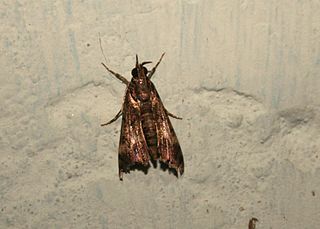Related Research Articles
Neargyractis is a genus of moths of the family Crambidae.
Neocataclysta is a genus of moths of the family Crambidae. It contains only one species, Neocataclysta magnificalis, the scrollwork pyralid moth, which is found in North America, where it has been recorded from Florida, Georgia, Maine, Massachusetts, Mississippi, New Jersey, New York, North Carolina, Nova Scotia, Ohio, Ontario and South Carolina.
Neocymbopteryx is a genus of moths of the family Crambidae. It contains only one species, Neocymbopteryx heitzmani, which is found in North America, where it has been recorded from Arkansas.
Neohelvibotys is a genus of moths of the family Crambidae.

Noorda is a genus of moths of the family Crambidae, and the only genus in the subfamily Noordinae.
Nyctiplanes is a genus of moths of the family Crambidae. It contains only one species, Nyctiplanes polypenthes, which is found in Australia, where it has been recorded from Queensland.
Nymphuliella is a monotypic moth genus of the family Crambidae described by William Harry Lange in 1956. It contains only one species, Nymphuliella daeckealis, known in the US as the china mark moth, described by F. Haimbach in 1915. It is found in the United States from New Jersey south to Florida and west to Colorado.
Odontivalvia is a genus of moths of the family Crambidae. It contains only one species, Odontivalvia radialis, which is found in North America, where it has been recorded from Texas.
Pseudoligostigma is a genus of moths of the family Crambidae.

Perispasta is a genus of moths of the family Crambidae. It contains only one species, Perispasta caeculalis, or Titian Peale's pyralid moth, which is found in North America, where it has been recorded from Quebec west to British Columbia, south to Florida, Texas and Colorado. The habitat consists of fields and meadows. Both the genus and species were first described by Philipp Christoph Zeller in 1875.
Piletosoma is a genus of moths of the family Crambidae.
Portentomorpha is a genus of moths of the family Crambidae. It contains only one species, Portentomorpha xanthialis, which is found from Texas to Louisiana and Florida, the West Indies and from Mexico to Bolivia.
Prolais is a genus of moths of the family Crambidae. It contains only one species, Prolais elbursalis, which is found in Iran.
Symphonia is a genus of moths of the family Crambidae.
Sclerocona is a genus of moths of the family Crambidae. It contains only one species, Sclerocona acutella, which is found from Spain and Sicily north to Great Britain and Denmark and east to Siberia, Japan and China. It is an introduced species in eastern North America.
Semniomima is a genus of moths of the family Crambidae.
Stegea is a genus of moths of the family Crambidae.
Stegothyris is a genus of moths of the family Crambidae. It contains only one species, Stegothyris fasciculalis, which is found in Madagascar and South Africa.
Thevitella is a genus of moths of the family Crambidae. It contains only one species, Thevitella alphalis, which is found in Madagascar.
Thyridiphora is a genus of moths of the family Crambidae.
References
- ↑ "global Pyraloidea database". Globiz.pyraloidea.org. Retrieved 2011-10-11.
- ↑ mothphotographersgroup
- ↑ Grote, A.R., 1881. New moths chiefly from Arizona. The Canadian Entomologist, 13: 233
- ↑ Bug Guide
| This Odontiinae-related article is a stub. You can help Wikipedia by expanding it. |